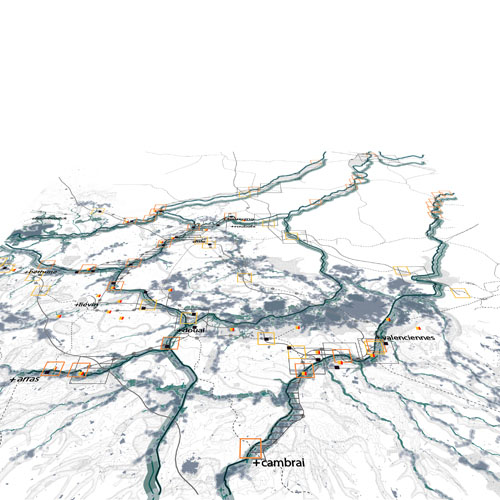The work, of nine months with the DREAL Lille Nord-Pas-de-Calais, was organized together with the support of three working groups; each one dedicated to different themes:’ the green and blue network” , “the urban fabric” and finally “the transport network”; enabled us to establish a coherent framework for the planning and transport for the metropolitan area of Lille.
The project inventory done by each one of the working groups, allowed us to represent the territory in a more conceptually way. Something that presented the same paradoxes that a description can bring which would not be the reproduction of reality and which forced us to choose what seems most important and relevant. We often tried to resolve this paradox limiting ourselves by what is "structuring," as if the concept of structure was very clear and obvious. Usually, confusion takes place considering as structuring what is larger, more massive, more expensive or which is proposed by the administration of a higher level.
By comparing the information gathered with the "form" of the territory and its history, it has been questioned how the proposed projects would eventually change the shape of the metropolitan area and the relationships they could establish with its long history. But the metropolitan area of Lille can be designed in different ways: as part of a vast metropolis that many researchers call the North Western Metropolitan Area, a metropolis that goes from Lille and extends it to Brussels, Antwerp , Rotterdam, Amsterdam and Cologne, or a smaller as a metropolitan area that has its main centers in the cities of Lille, Tournai and Kortrijk, or as an even smaller but highly articulated territory in which we can identify different parts with its own physical and social morphology: the mining area, the heart of the metropolitan area, areas of urban sprawl, the historic cities on its borders, etc.
It is likely that the only way to think seriously about coherence is to confront , as we did, the involved dynamics, the undergoing or planned projects, with scenarios that explore the impact that these projects can have in the future.
The conclusions of this work does not seems clear, it is not white either black, coherent or incoherent. It is much more complex , but it seems to be useful enough to start a debate at the metropolitan scale and to indicate some project management guidelines.
The methodology was based on the animation of meetings and crossing analysis of the data provided by the DREAL with our own ideas and research information. |

![]()